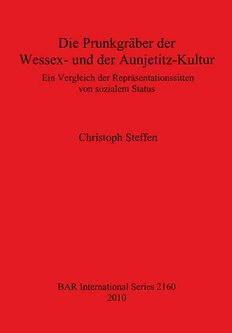
Die Prunkgräber der Wessex- und der Aunjetitz-Kultur: Ein Vergleich der Repräsentationssitten von sozialem Status PDF
126 Pages·2010·18.895 MB·German
Most books are stored in the elastic cloud where traffic is expensive. For this reason, we have a limit on daily download.
Preview Die Prunkgräber der Wessex- und der Aunjetitz-Kultur: Ein Vergleich der Repräsentationssitten von sozialem Status
Description:
The concept of this work is an intercultural comparison between the Early Bronze Age 'princely burials' of the south English Wessex Culture and the central European Aunjetitz Culture concerning the recognizable conventions of social status representation. The comparative study aims to review the hypothesis of a direct cultural relationship between the 'princely burials' of both cultures or to follow up the question, whether the appearance of such graves can be seen as an analogous or homologous cultural development. The main chapter deals with the identification, interpretation und comparison of conventions of status representation. Thereby all forms of expression that prehistoric societies used to denote high social rank in their burial customs were examined. The conclusion is that the Early Bronze Age elite burials in both regions seem to be a phenomenon that emerged because of socio-structural changes. Both cultures reacted similarly to changes that occurred around the beginning of the 2nd millennium BC, but each in their specific cultural context. The idea to build splendour graves did not travel either from the Wessex region to the Middle Elbe-Saale region or vice versa. Rather, similar social preconditions evolved during the same time in both areas.
See more
The list of books you might like
Most books are stored in the elastic cloud where traffic is expensive. For this reason, we have a limit on daily download.
